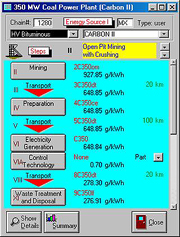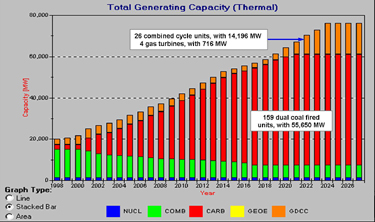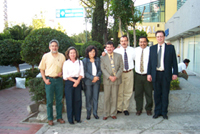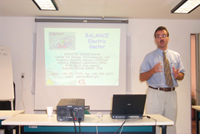| Center for Energy, Environmental, and Economic Systems Analysis (CEEESA) |  |
Research Areas:
Energy, Environment, and
Economics
National and Homeland
Security
Infrastructure Assurance
Emergency Preparedness
Social Dynamics
Policy Analysis
Core Capabilities:
Systems Analysis
Modeling, Simulation, and
Visualization
Complex Adaptive Systems
Decision Support and Risk
Management
Information Sciences
Capacity Building in Power Sector Analysis in MexicoBackground: Staff from the Center for Energy, Environmental, and Economic Systems Analysis (CEEESA) assisted Mexico’s government in the environmental analysis of the electric power systems. For this purpose, CEEESA collaborated with a team of experts from the Comisión Federal de Electricidad (CFE), the Instituto de Investigaciones Eléctricas (IIE), the Secretaría de Energía (SENER), and the Universidad Nacional Autónoma de Mexico (UNAM). The project was initiated by the International Atomic Energy Agency (IAEA) upon request by the Government of Mexico. The technical implementation was led by IAEA's Planning and Economic Studies Section (PESS). PESS implemented the project under its Sub-program C.1 (Energy Modeling, Databanks, and Capacity Building). The project was co-sponsored by the U.S. Department of Energy and the U.S. Department of State. Objectives of the project included the following:
Under Phase 2, the focus of the analysis extended beyond the power sector. In that phase, the team analyzed the entire Mexican energy supply and demand system using CEEESA's powerful ENPEP-BALANCE software. Using ENPEP-BALANCE to simulate Mexico’s energy markets, the team was able to analyze a number of different energy development scenarios and study their environmental implications, including both local pollution issues and global issues, such as long-term national carbon emission trends. Click here to see more information on Phase 2, which encompasses analysis of Mexico's entire energy system.
Results of Analysis: The power sector analysis was completed by June 2001. The team successfully analyzed a total of 14 scenarios for Mexico's power sector development. Scenarios included the following:
The load in the base year (1998) is 21,236 MW and grows at an average rate of 5.4% per year and reaches 37,962 MW by 2009. For the remainder of the study period, demand grows at 4.5% per year and reaches 73,686 MW by 2025. The chart to the left shows the projected system expansion under the Reference Case. Results clearly show the dominance of gas-fired capacity additions. The least-cost system expansion includes: 118 gas-fired combined-cycle units with a combined capacity of 64,428 MW, 6 gas-turbines with a combined capacity of 1,074 MW, and 5 committed hydro-power plants with a total capacity of 2,539 MW. Combined cycles additions are reduced to 26 units (14,196 MW), while the majority of new additions are now dual-fired coal units (159 units with total of 55.650 MW). Relative to the base case, the high gas price scenario has the largest impact on the expansion plan. The total discounted system cost increases from US$53.1 to US$76.3 billion. A key result was the success of the capacity-building component of the project. CFE continues its regular use of DECADES as its in-house analysis tool to develop long-term power sector projections. Contact Jorge Fernandez at CFE ([email protected]) for more details on the DECADES implementation in Mexico and CFE's latest long-term power sector projections. Training and Capacity Building: As part of the project, CEEESA provided training and implementation support to the Mexican team of experts. We have extensive expertise and experience in capacity building through the assistance we Training courses and workshops can be tailored to your specific needs and can last anywhere from a few days to a couple of weeks. Courses may be held at Argonne's facility in the Chicago area or at your facilities. Click here for information on past and upcoming training courses or click on the pictures below. Additional Resources: For more information on this application, download the following presentations and papers in pdf format:
For more information, contact CEEESA |
| U.S. Department of Energy Office of Science | UChicago Argonne LLC |
| Privacy & Security Notice | Contact Us | Search |
 Methodology: As part of the power sector project, CEEESA provided technical assistance to Mexico’s government on the comparative assessment of different electricity generation sources for the long-term electricity supply until 2025. The project started in February 1999 and was largely based on the DECADES (Databases and Methodologies for Comparative Assessment of Different Energy Sources for Electricity Generation) tools. DECADES was developed to enhance capabilities for incorporating health and environmental issues into comparative assessments of different electricity generation chains and strategies. Participating organizations include the European Commission (EC), the Economic and Social Commission for Asia and the Pacific (ESCAP), the International Atomic Energy Agency (IAEA), the World Bank, the International Institute for Applied Systems Analysis (IIASA), the Nuclear Energy Agency of OECD (OECD/NEA), the Organization of Petroleum Exporting Countries (OPEC), the United Nations Industrial Development Organization (UNIDO), and the World Meteorological Organization (WMO).
Methodology: As part of the power sector project, CEEESA provided technical assistance to Mexico’s government on the comparative assessment of different electricity generation sources for the long-term electricity supply until 2025. The project started in February 1999 and was largely based on the DECADES (Databases and Methodologies for Comparative Assessment of Different Energy Sources for Electricity Generation) tools. DECADES was developed to enhance capabilities for incorporating health and environmental issues into comparative assessments of different electricity generation chains and strategies. Participating organizations include the European Commission (EC), the Economic and Social Commission for Asia and the Pacific (ESCAP), the International Atomic Energy Agency (IAEA), the World Bank, the International Institute for Applied Systems Analysis (IIASA), the Nuclear Energy Agency of OECD (OECD/NEA), the Organization of Petroleum Exporting Countries (OPEC), the United Nations Industrial Development Organization (UNIDO), and the World Meteorological Organization (WMO).  The assumed load growth under the Reference Case for the interconnected system is shown in the graph to the left.
The assumed load growth under the Reference Case for the interconnected system is shown in the graph to the left. The impact of a substantially higher natural gas price on the system expansion is clearly demonstrated in the graph to the left.
The impact of a substantially higher natural gas price on the system expansion is clearly demonstrated in the graph to the left.  provide to our model users around the world in the form of training and implementation support. For more than 25 years, we have conducted training courses in many locations around the world and have successfully trained over 1,300 experts from
more than 90 countries in the use of our tools. Our models are actively in use in many of these countries.
provide to our model users around the world in the form of training and implementation support. For more than 25 years, we have conducted training courses in many locations around the world and have successfully trained over 1,300 experts from
more than 90 countries in the use of our tools. Our models are actively in use in many of these countries.
